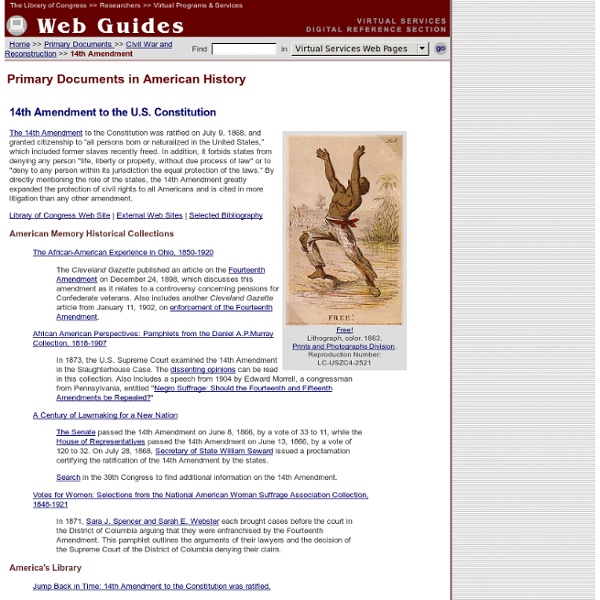America 1870-1920
NetHugs.com – Inspirational eCards 19Jul/1246 source: shorpy.com Tagged as: America, nostalgia, old photographsLeave a comment
Reconstruction: The Second Civil War
The Civil Rights Act of 1866 granted citizenship and the same rights enjoyed by white citizens to all male persons in the United States "without distinction of race or color, or previous condition of slavery or involuntary servitude." President Andrew Johnson's veto of the bill was overturned by a two-thirds majority in both houses of Congress, and the bill became law. Johnson's attitude contributed the growth of the Radical Republican movement, which favored increased intervention in the South and more aid to former slaves, and ultimately to Johnson's impeachment. 1866 Civil Rights Act 14 Stat. 27-30, April 9, 1866 A.D. CHAP.
US House of Representatives: History, Art & Archives
Image courtesy of Library of CongressA New York state politician for more than a decade, Representative Henry Raymond served only one term in the House of Representatives.
The Rise and Fall of Jim Crow . Jim Crow Stories . 14th Amendment Ratified
The Fourteenth Amendment was one of three amendments to the Constitution adopted after the Civil War to guarantee black rights. The Thirteenth Amendment abolished slavery, the Fourteenth granted citizenship to people once enslaved, and the Fifteenth guaranteed black men the right to vote. The Fourteenth Amendment was passed by Congress in June 1866 and ratified by the states in 1868.
Gettysburg Address history: Why "four score and seven years ago"?
Tuesday marks the 150th anniversary of Lincoln’s Gettysburg Address. In this excerpt from The Gettysburg Address: A Graphic Adaptation, by Jonathan Hennessey and Aaron McConnell, out now from William Morrow, the cartoonists explore the speech’s first six words. Excerpted from The Gettysburg Address: A Graphic Adaptation, by Jonathan Hennessey and Aaron McConnell, out now from William Morrow. Correction, Nov. 19, 2013: A panel in this excerpt misstated that the Hartford Convention of 1814-15 occurred during Thomas Jefferson’s presidency. It occurred during James Madison’s presidency. The original panel remains.
Reconstruction - American Civil War
At the outset of the Civil War, to the dismay of the more radical abolitionists in the North, President Abraham Lincoln did not make abolition of slavery a goal of the Union war effort. To do so, he feared, would drive the border slave states still loyal to the Union into the Confederacy and anger more conservative northerners. By the summer of 1862, however, the slaves themselves had pushed the issue, heading by the thousands to the Union lines as Lincoln’s troops marched through the South. Their actions debunked one of the strongest myths underlying Southern devotion to the “peculiar institution”–that many slaves were truly content in bondage–and convinced Lincoln that emancipation had become a political and military necessity.
Carpetbaggers & Scalawags - American Civil War
In general, the term “carpetbagger” refers to a traveler who arrives in a new region with only a satchel (or carpetbag) of possessions, and who attempts to profit from or gain control over his new surroundings, often against the will or consent of the original inhabitants. After 1865, a number of northerners moved to the South to purchase land, lease plantations or partner with down-and-out planters in the hopes of making money from cotton. At first they were welcomed, as southerners saw the need for northern capital and investment to get the devastated region back on its feet. They later became an object of much scorn, as many southerners saw them as low-class and opportunistic newcomers seeking to get rich on their misfortune.
Fourteenth Amendment
All persons born or naturalized in the United States, and subject to the jurisdiction thereof, are citizens of the United States and of the state wherein they reside. No state shall make or enforce any law which shall abridge the privileges or immunities of citizens of the United States; nor shall any state deprive any person of life, liberty, or property, without due process of law; nor deny to any person within its jurisdiction the equal protection of the laws. Section 2. Representatives shall be apportioned among the several states according to their respective numbers, counting the whole number of persons in each state, excluding Indians not taxed. Section 3.
The Civil War In Pictures, Part 1: The Places
Last year marked the 150th anniversary of the start of the American Civil War, a milestone commemorated by The Atlantic in a special issue (now available online). Although photography was still in its infancy, war correspondents produced thousands of images, bringing the harsh realities of the frontlines to those on the home front in a new and visceral way. As brother fought brother and the nation's future grew uncertain, the public appetite for information was fed by these images from the trenches, rivers, farms, and cities that became fields of battle. Today's collection is part 1 of 3, covering the places of the Civil War: the battleships, prisons, hospitals, urban centers, and rural pastures where history was made. Tomorrow's installment features some of the people involved in the conflict, and on Friday I'll be sharing some of the amazing three-dimensional stereographs of the war. Use j/k keys or ←/→ to navigate Choose:



